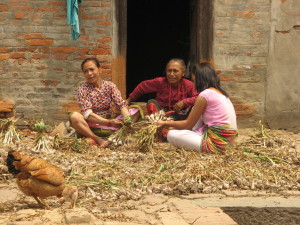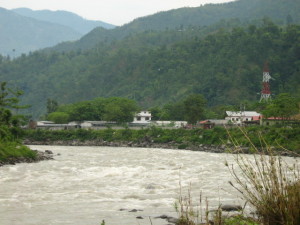By Kate Evans, originally published at CIFOR’s Forests News

The importance of migration to rural livelihoods in Nepal is not being recognized in forestry policy or by donors – and nor is the diversity of women’s experience, argues a chapter of a new book by the Center for International Forestry Research (CIFOR).
Thirty percent of Nepal’s GDP comes from remittances – the second highest proportion in the world. Around half a million people, or eight percent of Nepal’s total population, applied for a permit to work abroad in 2014 – 94 percent of them were men – and that does not include the many unregistered migrants or those who migrated within the country.
Despite this, Nepal’s recent Forest Sector Strategy (2012-2022) mentions migration just once.
“Nepal is considered a global model for mobilizing local communities to manage forests collectively – but by not addressing migration, the policy ignores how people are increasingly living their lives,” says Bimbika Sijapati Basnett, a CIFOR scientist, co-editor of the new book Gender and Forests, and author of the Nepal study, which forms part of the CGIAR Research Program on Forests, Trees and Agroforestry.
Nepal is well known for its widespread adoption of community forestry, where responsibility for managing forests is devolved to the people who live around them. But as international and circular migration for employment purposes becomes more common – and male-dominated – who actually lives there is in constant flux.

“There’s a very static and stationary understanding of people’s relations to forests,” Sijapati Basnett says. “Many households throughout the country have someone who’s gone abroad. So in that context you would expect that the forestry policy would acknowledge that – if it is about successful forest management, how do we motivate people to manage forests when they’re not just depending on forests, but on remittances too.”
Where migration is discussed, there tends to be a simplistic understanding of its impacts on forests and rural livelihoods, especially on gender relations, Sijapati Basnett says. Some assume migration is a problem to be solved, an outcome of the state’s failure to promote economic development and extend social services to its citizens, while others tend to say it’s a good thing for women, Sijapati Basnett says:
“[There’s an] idea that the men have left and the women are left behind, and now they’re being empowered because they’re the ones managing the forest and making all the decisions.”
“Or on the other side, there’s a tendency to ‘black-box’ women and assume they are always victims.”
In reality, Sijapati Basnett says, “migration is both a burden and a benefit for women who are left behind.” And their experience depends not simply on gender, but on how being female intersects with other aspects of social relations: age, ethnicity and, very importantly in Nepal, caste.

Case studies of two very different communities in rural Nepal illustrate just how important it is for policy makers not to assume there’s a uniformity to women’s experiences of forest management and migration.
Sijapati Basnett studied two forest-user communities in Nepal’s middle hills: the Tamang ethnic minority village of Bhatpole in Kavrepalanchowk District, and a low-caste Dalit (untouchable) group in the village of Gharmi in Kaski District.
In Bhatpole, most families rely on seasonal out-migration to support their livelihoods. Although Tamang culture is relatively egalitarian, with a history of both men and women migrating for work, recently external opportunities for women have diminished, and it’s now just the men who leave, often for six months or more.
In their absence, women took control of community forestry – comprising 9 out of 11 committee members. They did, however, seek strategic support from men in order to liaise with government officials in Nepali, as the men had more external contacts and were more comfortable with the Nepali language.
“We are more dependent on men than men are on us,” a Tamang woman told Basnett. “We depend on them for work and money – but we have learned that by cooperating amongst ourselves we can help each other out.”
In Gharmi, though many young men also migrate for work, gender relations are very different. The low-caste Biswa-Karma (Dalit) community share the village with two high-caste groups, and at the time of Sijapati Basnett’s research they were engaged in a bitter caste battle. The higher castes barred the Biswa-Karmas from entering their ‘sacred forests’ because of their ‘untouchability’ – but after three years of struggle, senior Dalit men convinced the government to hand over the community forests to them.
Though part of their argument was to gain secure access to forest products and reduce women’s work burden, the men excluded women from the community forestry committee and from any decision-making about the forests.
“I could tell very quickly there was something very regimented about their gender relations,” Sijapati Basnett says. “On the one hand there was all this discussion of freedom and patron-client relationships and untouchability, but on the other hand they were very similar to their [very gender-divided] high-caste neighbors.”
Women’s movement and sexuality was strictly controlled, and female migration was not an option.
“In both case studies it was men who were gone and women left behind – but the reasons why this was the case were so different. In Gharmi, it was because of inequalities within the community. In Bhatpole it was more about job opportunities for women and how that restricted their mobility. In terms of community forestry, in the Dalit group it was completely male-dominated, and in the Tamang community it was women who led the show and enlisted the men they thought could help negotiate.”
These examples show why the idea of the “homogenous Nepali woman” is problematic, Sijapati Basnett says.
“A certain level of abstraction is useful, but there needs to be a more nuanced approach – in fact, they’re not just nuances, but things that really matter for people: it means that the strategies you would use to empower women would be very different.”
And by ignoring migration in official policies, governments and civil society have missed an opportunity to ask useful questions that might help improve Nepalis’ lives.
“How do you use remittances to invest in forests, how do you provide incentives for that, how do you develop the forest sector in a way that reduces the very real risks of migration?”
“There are so many different questions, but it’s not being talked about,” Sijapati Basnett says. “By ignoring it or assuming it’s a problem you’ve eliminated the space for discussing it altogether.”











